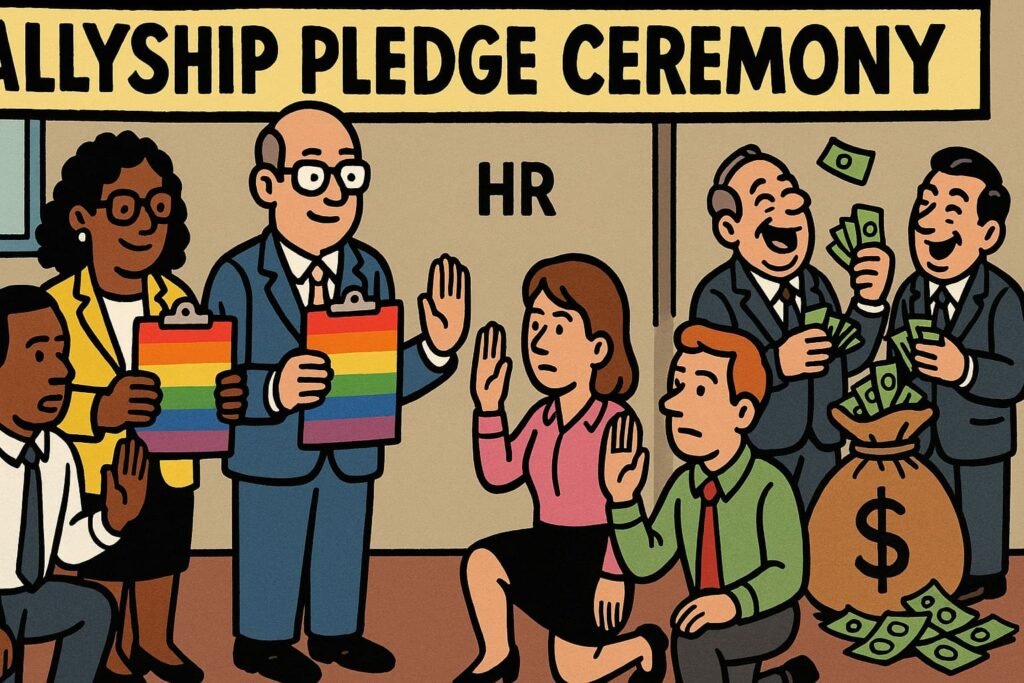Allyship Explained: The Endless Loyalty Test
Introduction: From Support to Submission
Once upon a time, being an ally meant standing with a friend. Simple solidarity.
Now? Allyship means constant pledges, hashtags, donations, and workshops. It’s not about helping. It’s about proving — over and over — that you’re loyal to the cause.
You’re never finished. You’re just “doing the work.”
Table of contents
What Is Allyship?
Allyship is the expectation that people outside a particular identity group must actively support it — not just privately, but publicly and visibly.
In activism, allyship is framed as a moral duty. In practice, it’s a ritual of confession, performance, and obedience.
Buzzwords
The jargon is familiar — and exhausting:
- “Do the work” – A demand for endless self-criticism and training.
- “Listen and amplify” – Translation: repeat slogans, don’t question them.
- “Silence is violence” – Even neutrality counts as betrayal.
- “Performative allyship” – If you do it for show, you’re wrong. If you don’t show it, you’re also wrong.
Heads they win, tails you lose.
How It Shows Up in Practice
- Workplaces require staff to sign allyship pledges or attend it seminars.
- Media praises celebrities for being “strong allies” — until they slip.
- Schools teach children to declare allyship with specific causes.
- Corporations plaster rainbows on logos every June as proof of allyship.
It’s solidarity transformed into branding.
Why Institutions Promote It
Because allyship keeps the pressure on.
- HR departments use it to enforce conformity at work.
- NGOs use it to keep donations flowing.
- Corporations use it to virtue-signal while ignoring class inequality.
- Activists use it to guarantee permanent leverage over supporters.
Allyship ensures obedience is never optional — it’s a subscription model for politics.
The Consequences
- Endless guilt. You can never do enough.
- Speech policing. Allies aren’t allowed to question or dissent.
- Division. Real solidarity replaced by loyalty rituals.
- Cynicism. Ordinary people see through the performance and stop trusting institutions.
Allyship doesn’t create unity. It creates fatigue.
Why It Matters
Allyship is the personal face of DEI culture. It’s how theories like equity, privilege, and inclusion translate into everyday behaviour — constant pledges of loyalty, constant fear of being branded a traitor.
It doesn’t bring people together. It keeps them in line.
From Solidarity to Obedience
Allyship promised support. What it delivered was obedience.
It’s not about helping others. It’s about proving yourself, forever, in a loyalty test you can never pass.
FAQ
What does it traditionally mean?
Standing with and supporting others in solidarity.
What does allyship mean today?
A permanent expectation of visible loyalty to activist causes, often enforced in workplaces and media.
Why is allyship controversial?
Because it replaces genuine solidarity with endless rituals of obedience.
Who benefits from allyship culture?
NGOs, HR departments, corporations, and activists who gain power and funding from constant loyalty displays.
How does allyship link to DEI?
It is the behavioural arm of Diversity, Equity, and Inclusion. It turns theories like Equity, Privilege, and Inclusion into daily pledges of loyalty.



